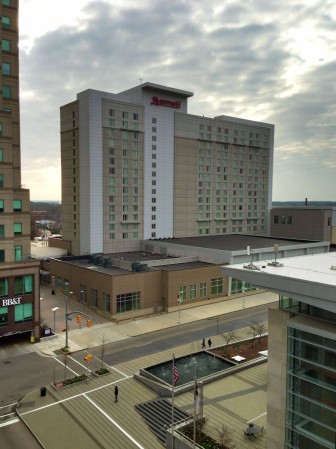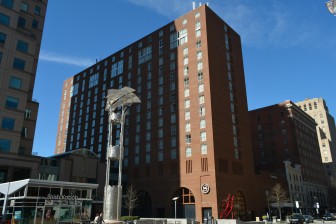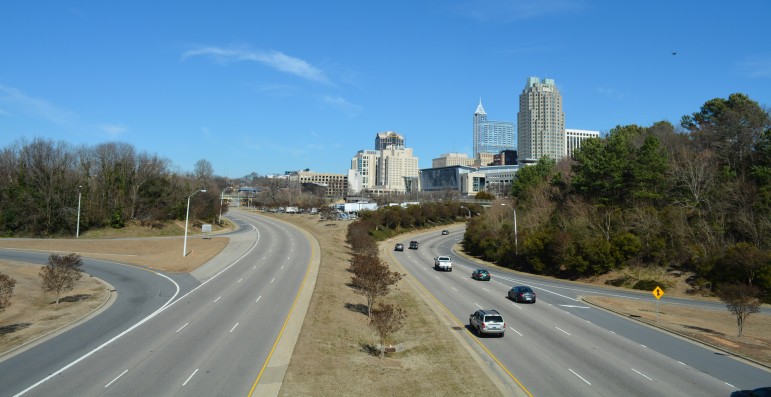Despite the tremendous growth and expansion of downtown Raleigh in recent years, the city’s numbers are still lacking in one area — hotel room availability.
The lack of available rooms — there are a total of 1,011 — has led city officials to advocate for increased building activity in the area that would help appeal to a larger-scale convention and trade show market.
City officials insist that the current number of hotel rooms available in downtown Raleigh do not allow the Raleigh Convention Center to compete with comparable convention centers across the nation.

James Borden / Raleigh Public Record
Raleigh’s Convention Center is located across from the downtown Marriott
The current 1,011 rooms are spread out among hotels in the downtown overlay district, which include the Raleigh Marriott City Center, the Sheraton Raleigh Hotel, the Holiday Inn-Raleigh Downtown, the Hampton Inn & Suites and the Days Inn.
The number of hotel rooms, or lack thereof, limits parties interested in the convention center and as a result limits business transient profit,said Loren Gold, an executive vice president of the Greater Raleigh Convention and Visitors Bureau.
“[There] are missed business opportunities due to our lack of downtown hotel inventory,” Gold said.
“In most cases we are limited by the size of the state, regional or national association or corporate conferences, conventions and trade shows that we can pursue. Not because of the size of the convention center, but because of the lack of supporting rooms.”
Lack of Rooms Not Always An Issue
This lack of rooms, however, does not affect all companies that book at the convention center, such as the recent LEGO KidsFest.
The LEGO KidsFest hosted five sold-out sessions in February and March of 2014. The organizers partnered with the Raleigh Marriott City Center and ran into no issues booking sufficient rooms for attendees.
The Sheraton also had another large event at the time, said Tracey Weiss, a LEGO KidsFest public relations representative.
While many of those who attended the event were locals who didn’t need hotel rooms, other conventions that attract a number of out-of-towners and business transient profit will be more likely to run into space issues.
Currently, the GRCVB can only pursue 20 percent of the convention market. This is based on current lodging inventory and convention center capacity. And it is a competitive market.
A feasibility study conducted in 2003 for the Raleigh Convention Center — which was built 5 years later — showed that cities of equal population and with similarly sized convention centers had average hotel room numbers between 1,500 and 2,000
Opportunity for Growth

James Borden / Raleigh Public Record
The Sheraton is one of Raleigh’s premier downtown hotels
According to Gold, adding 500-1,000 hotel rooms downtown would allow the GRCVB’s group sales team to strategically pursue 40 to 45 percent of the U.S. convention and trade show market.
“We have had incredible success to date with our current downtown hotel product and convention center,” Gold said. “But, our downtown convention business over time will remain flat without a sizable increase to our [hotel room] inventory.”
Downtown Raleigh’s vertical growth is no secret. It’s also no accident. The Raleigh City Council’s 2030 Comprehensive Plan includes specific elements that focus on growing Raleigh sustainably and moving away from sprawl-type development.
Hotels, transportation and other related infrastructure all contribute to Raleigh’s success and functioning as a whole, according to City Councilor Russ Stephenson.
“We want to develop Raleigh for all types of people,” Stephenson said. “Ideally, with larger [downtown hotel] capacity we can attract more conventions. The taxes on hotels help fund facilities such as the WakeMed Soccer Park and Marbles Kids Museum which in turn attract more visitors and benefit residents as well.”
The News & Observer reported in January that room rates for downtown hotels grew 7 percent from 2013 to 2014 while occupancy rates jumped 11.2 percent to 67.6 percent.
Despite these numbers, there has been a noticeable lack of recent building projects to get past the planning stages downtown.
However, a 166-room Residence Inn is about to begin construction near the convention center, according to Lacie Lindstaedt, Director of Communications with the Downtown Raleigh Alliance. A Hilton Garden Inn was also announced at 200 W. Davie, but it is now unclear where this project stands.
Planning For the Future
The City Council approved a downtown hotel feasibility study in December 2014.
A request for proposals to conduct that study has been issued, and submissions are due February 27.
This RFP will allow the funding parties, the City of Raleigh, the Downtown Raleigh Alliance, the Chamber of Commerce, and the Greater Raleigh Convention and Visitors Bureau, to select a study consultant. The feasibility study is expected to begin in March and last about four months.
“We see this as an economic development opportunity not only for the City of Raleigh but the surrounding area,” Gold said.
“Our hope is that with the prevailing economic conditions, the continued growth in downtown Raleigh, and the findings of the hotel feasibility study, the GRCVB’s sales team will be able to pursue double the number of conferences, conventions, and trade shows thus doubling the direct economic impact we currently bring to downtown Raleigh.”

James Borden / Raleigh Public Record
Downtown Raleigh is currently facing a hotel room shortage.
Editor’s note – a line the previous version of this article implied that Raleigh’s hotel occupancy rate had shot up from 11 percent to 67 percent – a fact that, if true, would be worthy of a story all its own.
